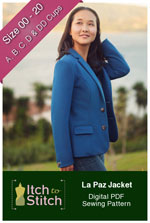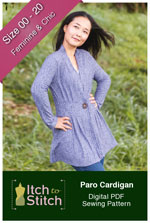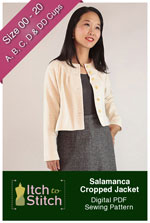digital causeway bomber jacket sewing pattern
The Causeway is a bomber jacket that can be made using a variety of fabrics from lightweight nylon to mid-weight embroidered cotton, so you can select one that matches your personal style. The timeless, casual bomber style is traditionally a short jacket with a ribbed collar and waistband as well as matching cuffs. The Causeway adds a touch of femininity with front princess seams that also give you a great fit in the bust. The optional invisibly zipped pockets are also embedded in the princess seams for a streamlined look. And you have the option to make the jacket reversible!
-
Itch to Stitch Digital Patterns
This style is provided as a digital pattern. It may be printed on home printers that use either 8 1/2" x 11" or A4 paper or at a print shop that can print A0-sized pattern sheets. When you complete your order, you will be provided with a unique code to instantly download the pattern. See our digital product policy for full details.
All Itch to Stitch patterns come as multiple PDF files consolidated within a single .zip file. Download and save the .zip file to a computer to access the PDF files. Downloading .zip files to mobile devices is not recommended as most phones and tablets cannot open them.
Description
The Causeway is a bomber jacket that can be made using a variety of fabrics from lightweight nylon to mid-weight embroidered cotton, so you can select one that matches your personal style. The timeless, casual bomber style is traditionally a short jacket with a ribbed collar and waistband as well as matching cuffs. The Causeway adds a touch of femininity with front princess seams that also give you a great fit in the bust. The optional invisibly zipped pockets are also embedded in the princess seams for a streamlined look. And you have the option to make the jacket reversible!
Causeway Bomber features:
- Options for cup sizes
- Relaxed, hip-length bodice
- Slightly dropped shoulders with long two-piece sleeves
- Optionally reversible (both sides are identical)
- Center front exposed zipper
- Ribbed collar, waistband and cuffs
- Front princess seams
- Optional invisibly zipped pockets on one or both sides of the jacket
- Layers feature (print only the sizes you need)
Sizes: 00 – 40
Suggested Fabrics
Fabric A: This is for the primary side of the jacket. The ideal fabric is lightweight to medium weight woven fabric without stretch. Nylon, cotton, rayon twill, crepe are good choices. Lightweight to medium weight woven fabric with a little stretch or a stable knit fabric such as a lightweight fleece is also acceptable but it will result in a more relaxed garment.
Fabric B: This is for the reverse side of the jacket. You can use similar fabric as Fabric A. If you choose to not make the jacket reversible, Fabric B should be a lining fabric such as Bemberg lining, lawn, batiste, lightweight woven fabric, silk, satin or other polyester linings.
Fabric C (Ribbing): The ideal fabric is ribbing fabric. Pre-made ribbing cuff can be used although it must be at least 7″ (18 cm) in length and you will have to piece the cuffs together to accommodate the width. Stable interlock fabric with good recovery is also acceptable.
Lining: This lining fabric is used for the pocket bags. Use a lightweight woven fabric such as Bemberg lining, lawn, batiste or other polyester lining are good choices.
Interfacing: Use lightweight woven fusible interfacing to cut the 1″ x 1″(2.5 x 2.5 cm) and 1″ (2.5 cm) wide by 21″ (54 cm) stated in Other Materials below. No pattern piece is provided.
Notions
- An open-end jacket zipper or longer—use a reversible zipper if you choose to make your jacket reversible; otherwise, use a regular, single-sided one
- Four pieces of 1″ (2.5 cm) wide straight-cut, lightweight woven fusible interfacing as long as the open-end jacket zipper. No pattern piece is provided.
- Two 7″ (18 cm) or longer invisible zippers for each set of pockets you decide to make.
- 3/8” or 1/2” (1 cm or 1.25 cm)-wide straight fusible stay tape (or cut your own using lightweight woven fusible interfacing on the straight grain).
- Eight pieces of 1″ x 1″(2.5 x 2.5 cm) lightweight woven fusible interfacing. No pattern piece is provided.
Size Chart, Finished Measurements, and Fabric Requirements
Click to enlarge the final images at above right.
Choosing your Size
- Determine your cup size—subtract the circumference of your over bust from the circumference of the fullest part of your bust. If the rounded difference is 1″ (2.5 cm), use A cup; 2″ (5 cm), use B cup; 3″ (7.5 cm), use C cup; 4″ (10 cm), use D cup; 5″ (12.5 cm), use DD cup.
- After determining the cup size, compare your bust circumference (fullest part) to the “Body Measurements” table. Using the corresponding row for your cup, choose the size that best fits your bust. If you are between sizes, choose the smaller size if you like your garment more fitted; otherwise, choose the bigger size.
- Compare your waist circumference (narrowest part) to the “Body Measurements” table. Choose the size that best fits your waist. If you are between sizes, choose the smaller size if you like your garment more fitted; otherwise, choose the bigger size.
- Compare your hip circumference (widest part) to the “Body Measurements” table. Choose the size that fits your hip best. If you are between sizes, choose the smaller size if you like your garment more fitted; otherwise, choose the bigger size.
- It’s OK to use different sizes for the bust, waist and hip. The instructions for blending sizes are included in the pattern.
- If you are taller or shorter than 5’6” (168 cm), you should consider lengthening or shortening the garment. The instructions for lengthening or shortening are included in the pattern.
- It is highly recommended that you check your fit by making a test garment with inexpensive fabric that has similar weight as your final garment fabric.
-
Be the first to review this item.














